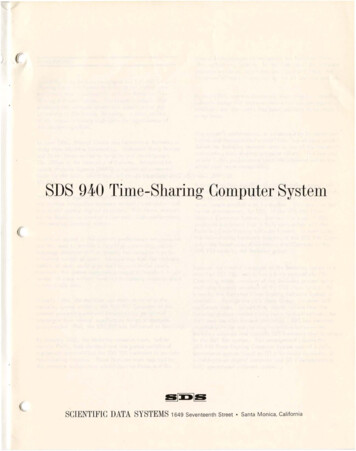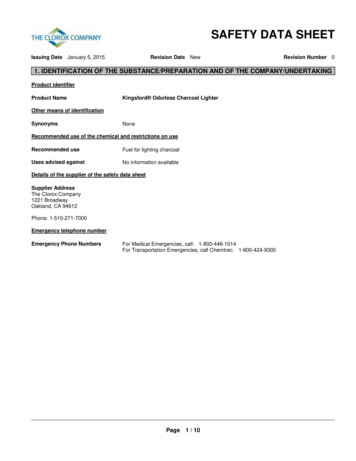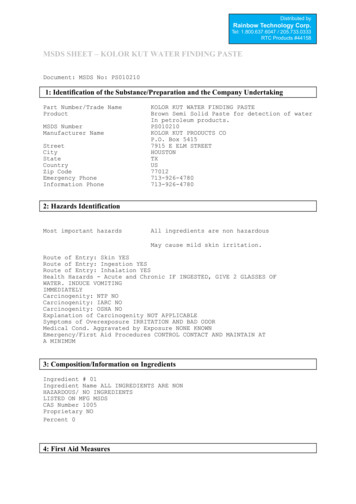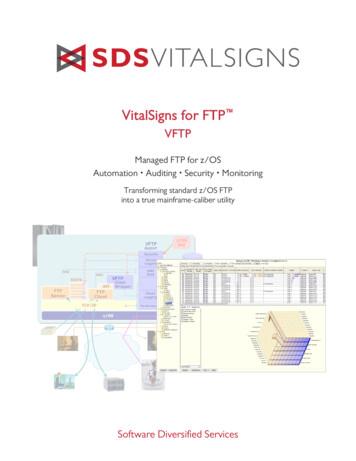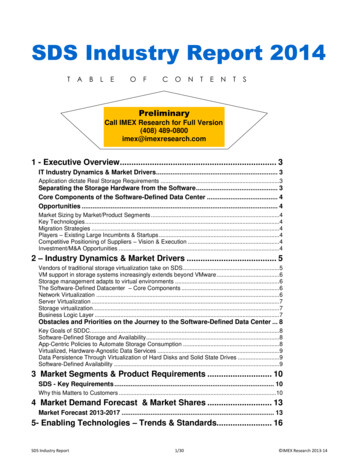
Transcription
SDS Industry Report 2014T A B L EOFC ON T EN TSPreliminaryCall IMEX Research for Full Version(408) 489-0800imex@imexresearch.com1 - Executive Overview. 3IT Industry Dynamics & Market Drivers . 3Application dictate Real Storage Requirements .3Separating the Storage Hardware from the Software . 3Core Components of the Software-Defined Data Center . 4Opportunities . 4Market Sizing by Market/Product Segments .4Key Technologies .4Migration Strategies .4Players – Existing Large Incumbnts & Startups .4Competitive Positioning of Suppliers – Vision & Execution .4Investment/M&A Opportunities .42 – Industry Dynamics & Market Drivers . 5Vendors of traditional storage virtualization take on SDS .5VM support in storage systems increasingly extends beyond VMware .6Storage management adapts to virtual environments .6The Software-Defined Datacenter – Core Components .6Network Virtualization .6Server Virtualization .7Storage virtualization .7Business Logic Layer .7Obstacles and Priorities on the Journey to the Software-Defined Data Center . 8Key Goals of SDDC.8Software-Defined Storage and Availability .8App-Centric Policies to Automate Storage Consumption .8Virtualized, Hardware-Agnostic Data Services .9Data Persistence Through Virtualization of Hard Disks and Solid State Drives .9Software-Defined Availability .93 Market Segments & Product Requirements . 10SDS - Key Requirements . 10Why this Matters to Customers .104 Market Demand Forecast & Market Shares . 13Market Forecast 2013-2017 . 135- Enabling Technologies – Trends & Standards. 16SDS Industry Report1/30 IMEX Research 2013-14
6- Competitive Product Positioning & Strategies . 19Traditional vs Virtualization Suppliers . 19Large Storage Suppliers - Incumbents. 19Total System Suppliers .19Hardware Suppliers .19Software Suppliers .19Emerging Start-Ups . 19System Integrators . 197- Suppliers: Portfolio & Strategies . 21Software-only Vendors .21Hardware Vendors Offering Software-only Storage.21Storage Appliance Vendors .218- Go To Market Channels . 259- Recommendations . 28Recommendations for Vendors . 28Recommendations for System Integrators . 28Recommendations for End Users by Vertical Industry . 28Recommendations for Wall St /Investment Bankers . 2910- Methodology & Appendices . 30SDS Industry Report2/30 IMEX Research 2013-14
1 - Executive OverviewThe report defines and segments the global SDDC market into various sub-segments with in-depthanalysis and forecasting of revenues. It identifies drivers and restraints for this market with insights intotrends, opportunities, and challenges. MarketsandMarkets has segmented the global data centersecurity market by type of solutions: software defined network, software defined server, software definedstorage; by end users: telecommunication service providers, cloud service providers, enterprise; byregions: North America (NA), Asia Pacific (APAC), Europe (EU), Middle East and Africa (MEA) and LatinAmerica (LA).IT Industry Dynamics & Market DriversStorage infrastructure that is managed and automated by intelligent software as opposed to by thestorage hardware itself. In this way, the pooled storage infrastructure resources in a software-definedstorage (SDS) environment can be automatically and efficiently allocated to match the application needsof an enterprise.Application dictate Real Storage RequirementsUltimately, applications know what characteristics of storage they require in terms of performance level,cost, size, resiliency and location. Applications request this by sending API calls for virtual volumesmeeting these characteristics. SDS simply translates these API calls into a set of instructions thatautomatically and on-the-fly provisions storage be they in Block, File or Object stores in the Disk basedDAS, NAS or SAN or at appropriate tiered pools of RAM, Flash and Disk that closely meet theseapplication requirements.However, there is absolutely no reason at all to further go down the path of storage silos, where theNetApp guys, the EMC guys and the Flash guys all are separated, without much knowledge of eachother or of application requirements.Separating the Storage Hardware from the SoftwareBy separating the storage hardware from the software that manages the storage infrastructure,software-defined storage enables enterprises to purchase heterogeneous storage hardware withouthaving to worry as much about issues such as interoperability, under- or over-utilization of specificstorage resources, and manual oversight of storage resources.The software that enables a software-defined storage environment can provide functionality suchasdeduplication, replication, thin provisioning, snapshots and other backup and restore capabilitiesacross a wide range of server hardware components. The key benefits of software-defined storage overtraditional storage are increased flexibility, automated management and cost efficiency.SDS abstracts the software that controls the storage functionality or services from the physical storagehardware.SDDCSoftware-defined data center (SDDC) is the phrase used to refer to a data center where all infrastructureis virtualized and delivered as a service. Control of the data center is fully automated by software,meaning hardware configuration is maintained through intelligent software systems. This is in contrast totraditional data centers where the infrastructure is typically defined by hardware and devices.Software-defined data centers are considered by many to be the next step in the evolution ofvirtualization and cloud computing as it provides a solution to support both legacy enterpriseapplicationsand new cloud computing services.SDS Industry Report3/30 IMEX Research 2013-14
Core Components of the Software-Defined Data CenterAccording to Torsten Volk, EMA, there are three core components of the software-defined datacenter: network virtualization, server virtualization and storage virtualization. A business logic layer isalso required to translate application requirements, SLAs, policies and cost considerationsOpportunitiesMarket Sizing by Market/Product SegmentsKey TechnologiesMigration StrategiesPlayers – Existing Large Incumbnts & StartupsCompetitive Positioning of Suppliers – Vision & ExecutionInvestment/M&A OpportunitiesSDS Industry Report4/30 IMEX Research 2013-14
2 – Industry Dynamics & Market DriversIt’s been decades now, but there was a time when all functionality was concentrated in the host.Input/output (I/O) operations and file systems were entirely managed by the host; disks were dumb,direct-attached devices. As functionality expanded, the CPU, memory and backplane (bus) becamethe performance bottleneck. Storage vendors responded to this market opportunity by providing morefunctionality in the storage array to the point where each now has its own operating system andembedded file system. With virtualization engines now handling more and more data movementData movement demands can be extremely resource-intensive, consuming all available memory andCPU cycles as well as saturating I/O channels.SDS creates the potential for scale-out storage that can use commodity hardware, in contrast to thetightly coupled software and hardware of traditional storage-area networks (SANs) and NAS systems.Vendors of traditional storage virtualization take on SDSStorage virtualization failed to catch fire the way some vendors hoped it might, but the buzz aroundsoftware-defined storage is giving them another chance to reposition their products. EMC lays out SDS vision with ViPR VMware pumps up software-defined storage strategy HP adds auto-tiering to StoreVirtual VSA Sanbolic Melio5 features distributed architecture Open source OpenStack Storage ties to virtualization infrastructure Software-based Red Hat Storage can run in VM environment Use cases for software-based Inktank Ceph Enterprise include VM storage CloudFounders jumps on software-defined storage bandwagon EMC views SDS as what storage virtualization should have been HDS CTO on virtual-oriented data storage DataCore Software chairman equates SDS to storage virtualization Vendors try to make storage virtualization as useful as server virtualizationBy increasing communication between the array and the hypervisor, VM-aware storage can provideadvantages such as improved data migration and performance. Tintri expands VM-aware storage line Hypervisor-aware storage provides per-VM reports VM-aware storage is one way to optimize performanceSDS Industry Report5/30 IMEX Research 2013-14
VM support in storage systems increasingly extends beyond VMwareStorage vendors have long supported the virtualization technology of the dominant vendor, VMware,and they've been gradually adding support for additional hypervisors, especiallyMicrosoft's Hyper-V.To read more about storage market trends related to VM support, check out the following 2013 stories: Gridstore zones in on Hyper-V performance Nutanix releases technical preview for Hyper-V Impact of second-generation Hyper-V on data storage VM-aware, hyper-converged storage beef up hypervisor support Storage features in Red Hat Enterprise VirtualizationStorage management adapts to virtual environmentsVendors continued to enhance both virtualization-specific and general storage managementtools toprovide more fine-grained insight into the performance of virtual environments. Dell updates Foglight virtualization management platform Windows Server 2012 R2 aids storage management for virtual environments VMTurbo expands resource management to virtual environments Monitoring, testing tools aid in planning, managing VDI Virtual server trends affect storage managementThe Software-Defined Datacenter – Core ComponentsIn part 1 of this series of four posts, we examined the grand vision of the software-defined datacenter (SDD). In this second post of theseries, we will take a look at the core components of the SDD (see Figure 1) and provide a brief evaluation of how mature these componentscurrently are.Figure 1 – Core Components of the Software-Defined DatacenterNetwork VirtualizationCreating the required network is a common reason for high provisioning times of new applicationenvironments. While it typically takes minutes to provision even a very large number of virtual machines,the requested networking resources often have to be created and configured at least semi-manuallyfrom multiple management interfaces. Not only does this process require advanced networking skills,but it can also lead to provisioning errors that can cause security issues. Software-defined networking(SDN) allows the user to simply specify which servers have to be connected and what the relevant SLAsare. The software then figures out the most efficient way of fulfilling these requirements without thetypical configuration-intensive process.Take a look at the following vendors: Cisco Systems, Nicira (now part of VMware), BigSwitch Networks,Lyatiss, Xsigo SystemsVMware’s acquisition of SDN-company Nicira and Oracle’s purchase of Xsigo, as well as significantinitial rounds of funding for multiple network virtualization and startups such as Big Switch, demonstratethat we are at the dawn of the age of network virtualization. We could compare today’s state of networkvirtualization with the status of server virtualization a little more than a decade ago. However, we canexpect market leaders such as Cisco Systems to adopt the concepts and protocols of networkvirtualization, such as OpenFlow, and therefore remain more relevant than server hardware vendorsSDS Industry Report6/30 IMEX Research 2013-14
over the past decade. Cisco’s significant investment in its own SDN startup, Insieme, is a great indicatorthat the company does not intend to allow its networking products to be commoditized without a fight.VMware and Cisco or VMware vs. Cisco?Many would regard VMware’s Nicira acquisition as an act of hostility toward Cisco Systems. VMware isbasically spending 1.26 billion on acquiring a startup that aims at shaving off the margins of Cisco’sbread and butter business. Of course, the Nicira acquisition is a long-term investment aimed at erodingCisco’s business only gradually; however, Steve Herrod’s quote definitely applies: “If you’re a companybuilding very specialized hardware you’re probably not going to love this message.”At the same time, Cisco is doing the right thing, expanding its leadership position by rapidly increasingits own SDN capabilities. The Open Network Environment constitutes Cisco’s initiative, based on theNexus 1000V switch, to make its networks open, programmable, and application-aware.Server VirtualizationPioneered by VMware over a decade ago, server virtualization is the most mature of the three SDDcomponents. Today, we see a trend toward organizations adopting multi-hypervisor strategies, in ordernot to depend on any one virtualization vendor and to take advantage of different cost and workloadcharacteristics of the various hypervisor platforms. Configuration management, operating system imagelifecycle management, application performance management, and resource decommissioning arecurrently the most significant server virtualization challenges. Many enterprise vendors, such as HP, CATechnologies, IBM, BMC, and VMware, currently offer solutions addressing these challenges.Storage virtualizationSimilar to SDN, storage provisioning has traditionally constituted a significant obstacle for many ITprojects. This is due to the often complex provisioning process that involves many manualcommunication steps among application owner, systems administrator, and the storage team. The latterhas to ensure storage capacity, availability, performance, and disaster recovery capabilities. Oftenstorage is overprovisioned to “be on the safe side.” Overprovisioning storage is expensive, as mostorganizations pay a significant premium to purchase a brand-name SAN. Today, when buying SANstorage, there typically is a significant brand loyalty and very little abstraction of storage hardware frommanagement and features. As in the instance of networking, when bundling hardware and software,vendors are able to achieve significantly higher markups compared to cases where hardware andmanagement software are unbundled.Take a look at the following vendors: Virsto, Nexenta, iWave, DataCore SoftwareThe concept of the “storage hypervisor” is currently gaining more and more traction. Similar to the SDNand server virtualization, the storage hypervisor enables customers to purchase any brand of hardwareand manage it via a centralized software solution. Abstracting the management software from the SANallows customers to manage multiple storage types and brands from one single software interface.Advanced features, such as high performance snapshotting, high availability across multiplegeographical locations, data stream de-duplication, and caching, are unbundled from the actual storagehardware, allowing customers to add on additional storage arrays of any brand, whenever needed.The EMC – VMware DilemmaEMC’s ownership of VMware can be seen as a strong inhibitor when it comes to advancing storagevirtualization, as EMC is certainly not interested in having its hardware margins taken away. Therefore,VMware has little incentive to contribute to the advancement of the hardware-independent storagehypervisor. However, we are now at a point where the company must face reality and acknowledge thatstorage hardware commoditization is inevitable. The significant investments of venture capital firms instorage virtualization companies – Virsto, Nexenta, Nutanix, NexGen Storage, PistonCloud, and manymore – demonstrate the inevitability of this development.Business Logic LayerAs a reminder from last week’s post on the basics of the SDD, a business logic layer is required totranslate application requirements, SLAs, policies, and cost considerations into provisioning andmanagement instructions that are passed on to the automation and orchestration solution. This businesslayer is a key requirement for the SDD, as it ensures scalability and compatibility with future enterpriseapplicat
Gridstore zones in on Hyper-V performance Nutanix releases technical preview for Hyper-V Impact of second-generation Hyper-V on data storage VM-aware, hyper-converged storage beef up hypervisor support Storage features in Red Hat
